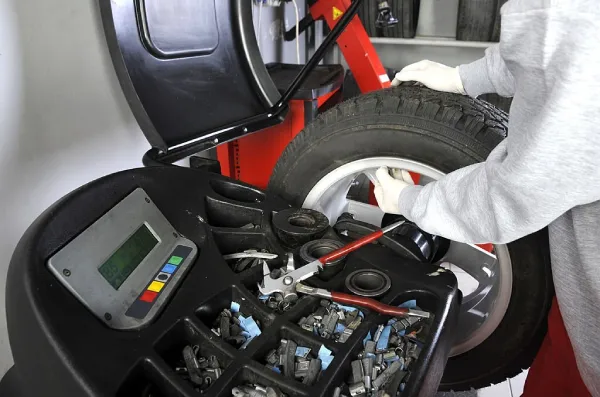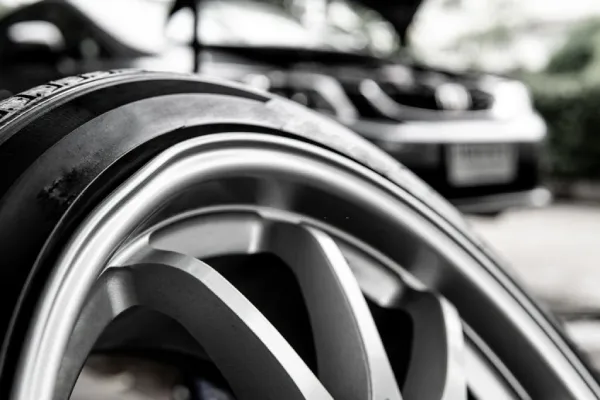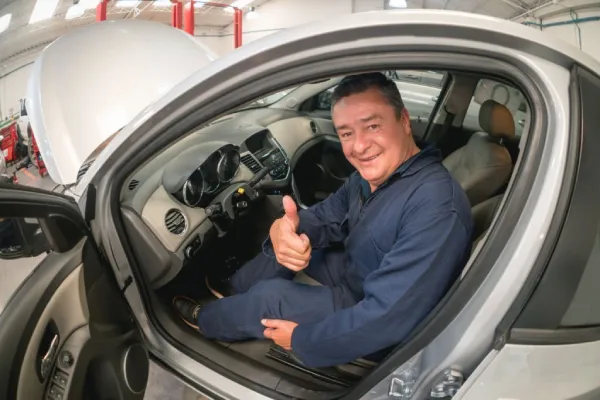Feeling a wobble in your tires when driving at low speeds can be an alarming sensation. As a long-time automotive repair expert, I know this issue strikes fear in many drivers as they grip the vibrating steering wheel. Though disconcerting, tire wobble is usually caused by some simple mechanical faults. Identifying the root problem is key to getting your vehicle smoothly back on track.
In this article, I’ll draw on my years of experience to walk you through the leading causes of tire wobble at low speeds. We’ll cover problems like unbalanced tires, bent wheels, worn suspension parts, and more. I’ll provide tips to diagnose the issue yourself as well as explain the proper repairs needed. You’ll learn how to inspect for tire cupping, test lug nut tightness, and look for damaged wheel bearings.
Main Causes of Tire Wobble at Low Speeds
When you start to feel an alarming wobble in your tires at low speeds, it’s important to pinpoint the root cause as soon as possible. In my experience, there are several common mechanical issues that can cause tires to wobble when driving under 40 mph:
Unbalanced Tires
One of the most frequent culprits of low-speed wobble is unbalanced tires. When tires are balanced, small weights are attached at certain points around the wheel to counterbalance any heavy spots on the tire. This keeps the weight evenly distributed and prevents vibrations. However, over time these tire balance weights can fall off, causing an abrupt imbalance in the tire.

When one or more weights detach, you’ll start to feel the tire wobble, especially at lower speeds. Getting your tires rebalanced will realign the weight distribution and eliminate the wobble. Tires should be balanced at least once a year to prevent imbalance issues.
Tire Cupping
If you notice the tread of your tires wearing unevenly in a scalloped cupped pattern, this tire cupping is likely causing the wobble. Cupped tires have high and low spots around the circumference of the tread due to improper inflation or suspension issues.
As these high spots spin around with the tire’s rotation, they make the tire bounce up and down subtly on the road. This creates an oscillating wobble effect at low speeds. The solution is to replace the cupped tires, as the tread damage is irreparable.
Bent Wheels

While less common, a slightly bent wheel can also lead to wobbling at low speeds. Even minor bends in a wheel’s rim can cause bumps and vibrations as it rotates. Carefully inspect the wheels for any visible flaws in the rim. If one is bent, even slightly, it will need to be replaced to stop the wobble.
Worn Suspension Parts
The various components that make up your suspension system – ball joints, control arms, tie rods, struts, shocks, etc. – wear down over time. Excessively worn suspension parts allow too much instability and play in the wheels. This leads to wobbling and vibrating, especially at lower speeds when turning. Have a mechanic thoroughly inspect all suspension parts front and rear. Any pieces deemed too worn will need replacement to restore stable wheel control.
Loose Lug Nuts
Before investigating more complex causes, first check to make sure your lug nuts are tight. Loose lug nuts are a simple oversight that can lead to annoying wheel wobble. Overtightening lug nuts can also cause issues, so make sure they are torqued to the automaker’s specifications. Periodically check torque levels yourself or ask your mechanic to check and retorque them if needed. This quick fix may cure your wobble worries.
Damaged Wheel Bearings
Wheel bearings allow the tire and wheel assembly to spin freely along the axle shaft. If the bearings become excessively worn or damaged, it can lead to wobbling vibrations especially noticeable at highway speeds. Bad bearings may emit a humming or growling noise too. Have a mechanic verify bearing condition, and replace any that are worn out or damaged. This will restore smooth, quiet wheel rotation.
Separated Tires
In the most severe cases, extremely bad tire wobble coupled with loud slapping noises at very low speeds may indicate a tire that is separating from the wheel. This dangerous situation requires pulling over immediately and replacing the defective tire. Separated tires can fully detach at speed, causing loss of control. Don’t hesitate to change out a badly wobbling tire that seems to be coming apart from the wheel.

By understanding the most frequent mechanical issues that can cause tires to wobble at low speeds, you can more readily diagnose the problem in your own vehicle. Take the time to carefully inspect your tires, wheels, lug nuts, suspension and bearings if you notice persistent wobbling under 40mph.
In most cases, you’ll be able to pinpoint the culprit and make the necessary repairs to get your car riding smoothly once again. You should not delay the repair, as prolonged imbalance can accelerate wear on tires and suspension parts.
Related content: What does it mean when cords are showing on your tires?
Diagnosing Tire Wobble
Figuring out the cause of annoying tire wobble at low speeds takes some detective work, but methodically inspecting components will help you pinpoint the root issue. Based on years assessing tire wobble concerns, here are the key areas I check and tests I perform to diagnose the problem:
Inspect Tire Tread
First, visually inspect the tread of the wobbling tire for signs of uneven wear. Check if the tread depth varies around the circumference or if there are distinct cupped areas worn into the tread surface. This cupped scalloped pattern indicates the tire itself is the problem and needs replacement. Tread evenly worn down with no gaps or spots means you can likely rule out the tire itself as the cause.
Have Tires Balanced
Next, have your tires balanced and look for any missing balance weights, the small pieces attached around the wheel to counterbalance heavy spots on the tire. Missing weights or weights that have fallen off can suddenly unbalance the wheel and lead to wobble issues. Rebalancing will re-distribute the weight evenly again. While having tires balanced, the technician can also check for bent rims or separated tires.
Check Lug Nuts
Loose lug nuts are one of the most preventable causes of tire wobble. Use a properly calibrated torque wrench to check each lug nut, or have a shop verify proper torque levels. Overtightened lug nuts can also cause wobble, so ensure torque specs match manufacturer directions. Tightening lug nuts evenly is critical to avoiding vibration issues.
Inspect Wheel Bearings
To check for worn wheel bearings, safely jack up the vehicle and support it on sturdy jack stands. With the wheel off the ground, wiggle the wheel side to side and up and down, feeling for any play or looseness. Too much play indicates worn bearings allowing the wheel excessive movement. Replace damaged or excessively worn wheel bearings to restore proper fit and reduce wobble.
Look at Suspension Parts
Worn suspension components like ball joints, control arms, bushings, and struts can also cause tire wobble as they allow too much wheel movement. Inspect the condition of all suspension parts, looking for damaged joints or bushings, bent components, or signs of fluid leaks indicating blown struts or shocks. Any excessively worn parts identified will need replacement to reduce wobble.
Test Drive at Varying Speeds

It’s important to pay attention to when and under what conditions the wobbling occurs. Test drive the vehicle at slower speeds, around 20-40 mph, and faster highway speeds. Issues like separated tires or bent rims typically cause very bad wobble at lower speeds. Wheel bearing or suspension problems may worsen at highway speeds. The speed conditions giving the worst wobble can help indicate the faulty component.
Switch Tires
In some cases, switching the front tires to the back can help determine if the tire and wheel are the issue or if it is a mechanical problem affecting the front or rear axle. If the wobble follows the tire, it points to a tire balance or deformation issue. If the wobble stays on the same axle, it indicates a component problem in the front or rear suspension.
While dealing with tire wobble can be frustrating, methodically inspecting the key areas outlined above helps isolate the problem. Let’s see how to fix the issue once you identify what is causing the problem.
Related content: Car Making Creaking Noise When Driving Slowly! Here’s Why!
Solutions for Tire Wobble
Once you’ve diagnosed the cause of annoying low-speed tire wobble, it’s time to make the necessary repairs to get your vehicle riding smoothly again. Drawing from my repair experience, here are the steps to take to fix the most common causes of tire wobble:

Rebalance Tires
If inspection revealed missing balance weights on your tires, get them rebalanced right away. This redistributes weight around the tire evenly, eliminating vibration. Most tire shops can quickly rebalance tires for a modest fee. They will add new weights as needed to smooth out the ride.
Replace Tires
Tires with uneven cupped wear patterns or belts separating from the tread must be replaced, as uneven tread is causing the wobble. Install a matching new tire to the same wheel that has the cupped tire to prevent size or tread depth differences between tires. The whole set may need replacement if wear is extremely uneven. Proper inflation going forward will help prevent reoccurrence.
Tighten Lug Nuts
Loose lug nuts are a quick fix – simply tighten them to the automaker’s torque specifications in the proper star pattern. Use a calibrated torque wrench for precise tightening. Don’t overtighten, as this can warp rotors or wheel hubs. Periodically check torque specs as lug nuts can loosen over time, leading to wobble.
Replace Bearings
If worn wheel bearings are the culprit, they must be replaced to reduce play allowing the wobble. This may require pressing out the old bearing and carefully installing the new one. A professional mechanic can ensure proper bearing fit and torque for long bearing life. Reset any ABS sensors disturbed in the process.
Replace Suspension Parts
Any ball joints, control arms, tie rods, struts, or other suspension components identified as excessively worn will need replacing to tighten up suspension play. This may require special tools to detach sagging parts from the steering and suspension assembly. Only use OEM or high-quality replacement parts to maintain proper handling.
Inspect Wheels
Even slightly warped or bent wheels can cause annoying wobble. If a damaged wheel is suspected or diagnosed, replacement is the only option, as bent wheels cannot be straightened. Use care when installing the replacement to avoid re-bending the new wheel. Check lug nut tightness frequently on the new wheel.
Replace Separated Tires
A tire that is badly wobbling with visible signs of tread separation from the belts requires immediate replacement, as separation can cause sudden air loss or blowout. Remove any bubbles or bulges around the tire sidewalls during installation to prevent further separation issues.
Get A Wheel Alignment
Getting an alignment is critical after any suspension or tire work to reset angles and ensure straight tire wear. This will also eliminate pull or drift resulting from repairs. Opt for high-end alignment with measurements to exact OEM specifications for proper handling.
Verify Repairs
Finally, extensively test drive the vehicle after repairs, monitoring for any residual wobble issues. Run it through a variety of road conditions and speeds to confirm it now tracks straight and vibrations have been eliminated. If any wobble persists, further inspection of related components may be required to pinpoint the cause. Don’t assume the issue has been fixed until thoroughly vetted.
FAQ
What causes tire wobbling?
The most common causes of tire wobbling are unbalanced tires, uneven tire wear (tire cupping), bent wheels, loose lug nuts, bad wheel bearings, and worn suspension components.
At what speeds does tire wobble occur?
Tire wobble can occur at various speeds depending on the cause:
- 15-20 mph – Likely a separated tire, which is extremely dangerous
- 40-60 mph – Usually indicates unbalanced tires
- Lower speeds – Can be caused by tire cupping, bent wheels, or bad bearings
How can I diagnose the cause of tire wobble?
Inspect tires for uneven wear, test lug nut tightness, check for play in the wheel bearings, test drive at various speeds to isolate when wobbling occurs, and inspect suspension components. Switching tires can help isolate a bad tire or wheel.
Is it safe to drive with a wobbling tire?
No, any tire wobble should be addressed immediately as it can lead to blowouts, loss of control, and damage to wheels and suspension. Separated tires require immediate replacement.
How do I fix tire wobble?
Solutions depend on cause – balancing or replacing tires, tightening lug nuts, replacing bearings and suspension parts, aligning the vehicle, and replacing damaged wheels.
Closing Thoughts
Dealing with an annoying tire wobble at low speeds can be unsettling but is usually fixable by identifying the root cause and making the necessary repairs. As we’ve covered, common issues like unbalanced tires, worn wheel bearings, bent wheels, and loose lug nuts are typical culprits of tire wobble.
Carefully inspecting your tires, wheels, suspension parts, and drivetrain components can help pinpoint the problem area. Rebalancing tires, replacing damaged parts, and proper torqueing of lug nuts are straightforward repairs that can eliminate most wobbling issues.
While a vibrating tire may only seem like an inconvenience, prolonged wobble can lead to bigger problems if left unchecked. The shaking motion can rapidly wear tires and wheels, loosen lug nuts, and damage suspension components.
Severe wobble at highway speeds is particularly dangerous, so address any wobble issues promptly. Performing regular tire inspection and rotation, wheel balancing, and suspension maintenance can minimize odds of wobble happening in the first place.
Engineering Coordinator with 5+ years of experience in the automotive manufacturing industry. Currently supporting vehicle development and new model launch activities at Honda Development and Manufacturing of America. Skilled at managing engineering teams, overseeing prototype builds, coordinating testing, and driving continuous process improvements. LinkedIn








